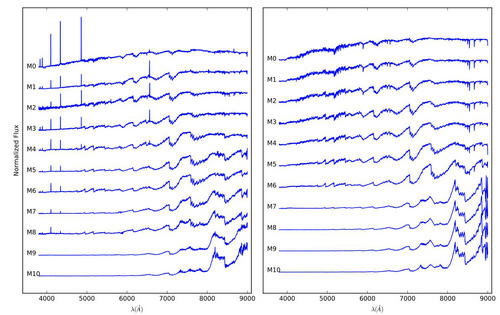Recently, Yuhan Yao of Peking University, Chao Liu of National Astronomical Observatories of CAS (NAOC) and others discovered 191 new Mira candidates from the LAMOST DR4 data. This study has already been accepted by The Astrophysical Journal Series-- an internationally renowned astronomical journal.
Mira stars are a class of long period variables with periods in excess of 80 days that coincide with the final stellar evolutionary phase of low-to intermediate-mass (1–8 M⊙) stars before the envelope ejection phase. Because they are visible beyond the Local Group, and their distances can be roughly determined by their period-luminosity relationship, Miras have long been used as tracers of many astrophysical problems. For example, the picture of their chemical composition and spatial distribution can help to probe the structure and evolution of the Milky Way Galaxy (MWG). Therefore, the more Miras we know, the better we understand the MWG.
Traditionally, the search of Mira stars involves long-term IR photometry followed by carefully planned spectroscopic observations. Thanks to LAMOST, we now have a chance to search for Miras based on their spectral characteristics. Different from normal giant stars, the spectra of Mira stars have high-excitation emission lines of hydrogen and some metal elements. By measuring the intensity of emission lines, absorption bands, and using the archival near-infrared photometric data (2MASS), the researchers have found 191 new Mira candidates from millions of spectra in the LAMOST DR4 catalogue. Photometric follow-ups are needed to confirm that these candidates are bona fide Mira stars.
In addition, the researchers compiled a sample of 281 spectra of known Mira stars, including 12 early-type Miras that previously had not been carefully studied because of their rareness. After comparison and quantification, they found a relationship between relative Balmer emission-line strength and spectral temperature of O-rich Mira stars. The relative flux of higher orders in the Balmer series (Hdelta) increases as stars cool down from M0 to M10, which is likely driven by increasing TiO absorption above the deepest shock- emitting regions.
This research is supported by the Hui-Chun Chin and Tsung-Dao Lee Chinese Undergraduate Research Endowment (CURE), the National Key Basic Research Program of China and the National Natured Science Foundation of China.
This paper is available at https://arxiv..org/abs/1708.04703

Left: LAMOST spectra of Mira stars, with decreasing temperature from M0 to M10.Right:spectra of normal M giants.